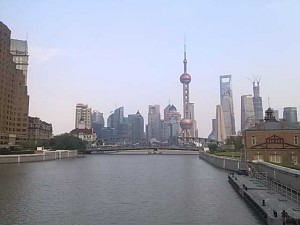Shanghai Street View: River Respite

In 6 years of living in Shanghai, I’ve come to discover my adopted China hometown has a major common characteristic with my US adopted hometown of Los Angeles. Both are major cities that are quite comfortable for people who live there, but are far less notable as tourist destinations.
In this week’s Street View, our city is in the headlines for major new plans that promise to make huge swaths of land on both sides of the Huangpu River friendlier for not only local residents but also tourists. I’ve seen the main plan discussed several times before, but the latest reports say work is already nearing completion on creation of continuous spaces that will allow people to walk for long distances on both sides of the river.
In total, the plan will see the roll-out of a 22-kilometer continuous path on the Puxi side of the river, centered on the old Bund area, and a similar-length path on the Pudong side.
The other major plan has seen the near-completion of a historic market on the actual Bund, which will reopen next year as the centerpiece of a new shopping and cultural complex called Bund Central.
These kinds of projects are exactly what Shanghai needs to improve life for both tourists and locals, drawing on the city’s historical sites and the river flowing through its center to create attractions and spaces with their own unique local flavor. The Huangpu riverfront is especially important in Shanghai’s identity, since the city’s earliest major settlement is the Yuyuan garden located near the river’s banks, and its more modern history is firmly anchored by the series of colonial-era buildings on the Bund itself.
Shanghai’s plan contrasts sharply with many other major Asian hubs like Hong Kong and Singapore, where city officials are often beholden to real estate developers and therefore can’t create these kinds of distinctive pedestrian-friendly attractions. Hong Kong is the most notable, with only a handful of short walkable stretches along the scenic Victoria Harbor that lies at the center of the former British colony. Most of the rest of the harbor is lined with buildings, roads and other impassible areas, depriving the public of places to find refuge during their daily urban life.
Shanghai and many other Chinese cities were often even worse in the 1990s and first part of the 21st century, with most of their urban waterways inaccessible to pedestrians due to heavy development along their banks. Some of my earliest memories of cities like Shanghai, Chengdu and Guangzhou in the 1980s was the clutter of homes, shops and other buildings on the banks of the major rivers that flowed through their centers, usually making it impossible for pedestrians to enjoy these waterways.
Shanghai and many other cities have been gradually reclaiming those riverbanks and their valuable real estate by knocking down older structures and creating more pedestrian-friendly parks, restaurants and shops in their place. But this latest plan by Shanghai is one of the most ambitious I’ve seen, and has the potential to truly transform the city by returning the Huangpu River to its historic position as the center of our city.
The continuous space on the Puxi side will extend all the way from Hongkou in the north down to the Xuhui District in the south, with the actual Bund area at its center. On the Pudong side the continuous space will extend from the Yangpu Bridge in the north to the Xupu Bridge in the south, linking up areas including the Expo park and Lujiazui financial district.
Long Walks, Jogs
Upon completion of the project next year, people should be able to take long jogs and walks along either side of the river and eventually enjoy a number of parks and other pedestrian-friendly shops and attractions along the way.
The other smaller project will be anchored by the revamped 5-story market on East Nanjing Road, a neoclassical building that was closed in 2006 and has been undergoing a major renovation since 2013. The entire Bund Central complex, consisting of the market and 6 other buildings, will reopen next year. It certainly sounds like it has the potential to become a major attraction for both locals and tourists, though we’ll have to see how well the plan was actually executed before passing final judgment.
Shanghai certainly isn’t alone in doing this kind of restoration, and is taking its cue from western cities that have also made similar overhauls of waterside areas that used to be largely industrial due to their historic role as shipping hubs. But I do quite like Shanghai’s aggressive approach to reclaiming the entire riverfront, which is far more ambitious than anything I’ve seen anywhere else.
Such a plan will obviously force Shanghai to make some sacrifices, since such land is quite valuable and might be worth much more if developed as luxury homes and skyscrapers. But in the longer run it could help to rebuild the city’s reputation as both a major tourist destination, as well as one of China’s most livable cities for local residents.
